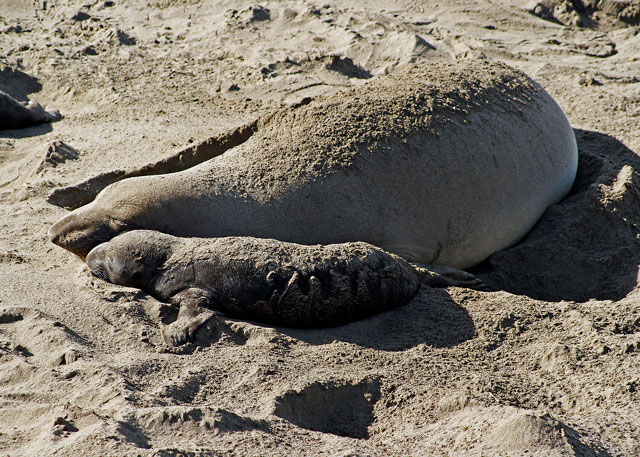
—Elephant seals started landing on the beach of Northern Elephant Seal Rookery at Piedras Blancas as early as 1990. Prior to that a group of seals had started colonizing a beach at Gordo, but they were not easily accessible or noticeable. The only other mainland colonies of elephant seals at the time were at Ano Nuevo and Point Reyes.
Thanks to the development of the Friends of the Elephant Seals volunteer organization, a long stretch of boardwalk has been constructed just above the Piedras Blancas rookery for public viewing. No one is allowed onto the beaches near the seals. Ample parking is available and the boardwalk is accessible from the parking lot. Viewing walkways at each end of the parking lot are part of the California Coastal Trail and are wheelchair accessible. Dogs must be on a leash.
The best rookery viewing areas are located 90 miles south of Monterey, five miles north of Hearst castle. The Piedras Blancas rookery spreads over six miles of beach from Point Piedras Blancas. Viewing areas are open every day. There are no fees or reservations required. No public transportation is available. There are no restrooms at the viewing area so plan accordingly
From near-extinction to colonies
These huge sea mammals were making a remarkable recovery from near extinction having been hunted for their blubber and oil during the 18th and 19th centuries. At the end of that period only 50 animals were left. From that small group came all the northern elephant seals on the Pacific Coast. Now there are breeding colonies from Baja to British Columbia and at four California sites.
Today, the Marine Mammal Center estimates the northern elephant seal population to be approximately 150,000 with 124,000 of that in California waters. The population at Piedras Blancas is around 20,000 elephant seals, but the seals are not all in the rookery at the same time because males, females and young seals come to shore at different times of the year for different reasons.
A new scientific project carried out in the sea just north of the rookery is the placement of a special buoy that records the presence and number of great white sharks that are known to attack elephant seals.
Elephant seals are protected by Federal law. Use of drones or model aircraft is illegal in the rookery area.
Adult males, females & pups
Adult male seals begin to come ashore here in late November, early December. These two-ton animals enter into battles for the prime spots on the beach. Alpha males, take charge of the space with beta males staying nearby; only alpha males will breed.
Females, most of whom are pregnant, come ashore in mid-December and form into harems around an alpha male. They are not necessarily choosing him, but are selecting the best places on the beach to give birth.
Pups are born throughout the month of January; by mid-January the beach is alive with small, black, wiggling pups and loud chirping sounds fill the air as they make known their desire to nurse. Nursing continues for four weeks and the pups eventually quadruple in size.
Winter viewing
From December through February, visitors will see the most activity in the rookery. For the most part, the seals lay motionless sleeping and flipping sand onto their backs. Every now and then fights will break out between females who challenge each other for the spaces they hold on the beach.
In mid-February females wean their pups and are ready to breed again. Alpha males pursue them and often roll over an unsuspecting pup in their eagerness to engage the females. Once bred, females leave the beach and go out to sea to feed. Males remain until the last female has gone.
June and July have the females and juveniles leaving and sub-adult males coming in to molt. These young males will practice-fight each other in anticipation of challenging larger males during next breeding season. In August and September, large males return to molt; there are fewer seals on the beach, but the biggest seals are all present.
October and November are the best months for the fall haul out of yearlings and juveniles followed up by another breeding season at the Piedras Blancas Elephant Seal Rookery.
In March, the pups, now called weaners, gather together and begin to venture down to the water and paddle around in the rocky tide pools. As they waddle across the beac, they are strengthening their muscles preparing them for the time they will go out to sea.
In April and May females and juveniles return to the beach, go through their yearly molt and shed both hair and the top layer of skin – the seals fast for the duration of the molt. Visitors will see upwards of 4,000 seals at the site during this time.
Learn more
To learn more and for information about watching the seals, visit the Friends of the Elephant Seal website at www.elephantseal.org. Check out the e-seal cam to watch live action in the rookery. The Visitor Center and Store is located at Cavalier Plaza in San Simeon.
—Ruth Ann Angus
